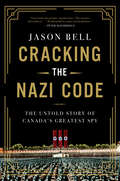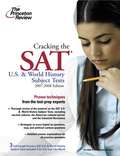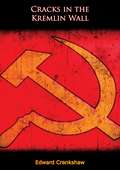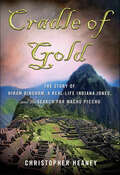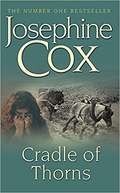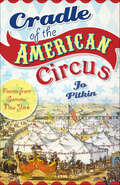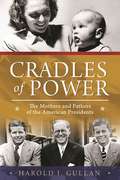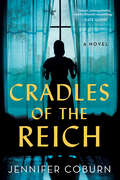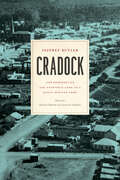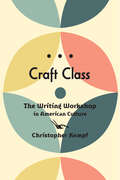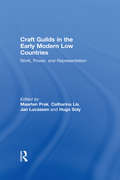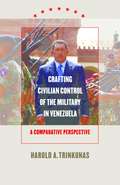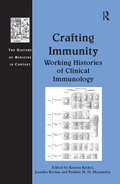- Table View
- List View
Cracking the Nazi Code: The Untold Story of Canada's Greatest Spy
by Jason BellThe thrilling true story of agent A12, the earliest enemy of the Nazis“Brilliantly researched. . . . A page-turner, one of those books not to be missed.” —Rosemary Sullivan, author of Stalin’s Daughter“Who knew that a Canadian was the first to warn the world what the Nazis were up to, and to do it years before anyone else was even talking about Nazis? Winthrop Bell is a name you should know, and thanks to Jason Bell and his deep-dive research, you now will.” —Peter MansbridgeIn public life, Dr. Winthrop Bell of Halifax was a Harvard philosophy professor and wealthy businessman. But as MI6 secret agent A12, he evaded gunfire and shook off pursuers to break open the emerging Nazi conspiracy in 1919 Berlin. His reports, the first warning of the Nazi plot for WWII, went directly to the man known as C, the mysterious founder of MI6. Throughout this, a powerful fascist politician quietly worked to suppress Bell’s alerts. Nevertheless, agent A12’s intelligence sabotaged the Nazis in ways that are only now being revealed. Bell became a spy once again in the face of WWII. In 1939, he was the first to crack Hitler’s deadliest secret code: the Holocaust. But the führer was a popular politician who said he wanted peace. Could anyone believe Bell’s shocking warning? Fighting an epic intelligence war from Ukraine, Russia and Poland to France, Germany, Canada and Washington, DC, A12 was the real-life 007, waging a single-handed fight against madmen bent on destroying the world. Without Bell’s astounding courage, the Nazis might just have won the war. Informed by recently declassified documents, Cracking the Nazi Code is the first book to illuminate the astonishing exploits of Winthrop Bell, agent A12.
Cracking the SAT U. S. and World History Subject Tests, 2007-2008
by Princeton ReviewThe Princeton Review realizes that acing the SAT U.S. and World History Subject Tests is very different from earning straight A's in school. We don't try to teach you everything there is to know about U.S. and world history--only the techniques and information you'll need to maximize your score. In Cracking the SAT U.S. and World History Subject Tests, we'll teach you how to think like the test writers and ·Learn what subject matter will be tested so you can study more effectively ·Review key historical eras that will appear on the test ·Use proven techniques to solve complicated questions The 2007-2008 edition of Cracking the SAT U.S. and World History Subject Tests is revised and updated to include the most current information possible.
Cracks in the Dome: Fractured Histories Of Empire In The Zanzibar Museum, 1897-1964
by Sarah LongairAs one of the most monumental and recognisable landmarks from Zanzibar’s years as a British Protectorate, the distinctive domed building of the Zanzibar Museum (also known as the Beit al-Amani or Peace Memorial Museum) is widely known and familiar to Zanzibaris and visitors alike. Yet the complicated and compelling history behind its construction and collection has been overlooked by historians until now. Drawing on a rich and wide range of hitherto unexplored archival, photographic, architectural and material evidence, this book is the first serious investigation of this remarkable institution. Although the museum was not opened until 1925, this book traces the longer history of colonial display which culminated in the establishment of the Zanzibar Museum. It reveals the complexity of colonial knowledge production in the changing political context of the twentieth century British Empire and explores the broad spectrum of people from diverse communities who shaped its existence as staff, informants, collectors and teachers. Through vivid narratives involving people, objects and exhibits, this book exposes the fractures, contradictions and tensions in creating and maintaining a colonial museum, and casts light on the conflicted character of the ’colonial mission’ in eastern Africa.
Cracks in the Kremlin Wall
by Edward CrankshawFirst published in 1951, this book by Edward Crankshaw, a leading authority on the U.S.S.R., explores the abandonment of normative Marxism and its eventual replacement by Great Russian nationalism, the predisposition of Russian society to submit to absolute regimes, and the striking ineptitude of Stalin’s foreign policy.
Cradle of Conservation: An Environmental History of Pennsylvania (Pennsylvania History)
by Allen Dieterich-WardFrom the origins of “Penn’s Woods” to the controversial practice of fracking, Cradle of Conservation provides the first comprehensive study of Pennsylvania’s environmental history. The story starts with forester Ralph Brock at the dawn of the conservation era and continues through the eras of energy production using coal, oil, natural gas, and other resources. Allen Dieterich-Ward also investigates how the non-human world shapes the history of the commonwealth and examines the impact of pollution. Cradle of Conservation moves across time and place, from the Haudenosaunee people of the Susquehanna Valley, to the iron furnaces of nineteenth-century Pittsburgh, to the diesel trucks on the twentieth-century Pennsylvania Turnpike. In addition, Dieterich-Ward explores the histories of Philadelphia’s Schuylkill River and the state’s anthracite region and traces the environmental movements and crises that have led to public policy changes in the face of climate change. Cradle of Conservation deepens our understanding of how Pennsylvanians have conserved and consumed.
Cradle of Gold: The Story of Hiram Bingham, a Real-Life Indiana Jones, and the Search for Machu Picchu
by Christopher HeaneyIn 1911, a young Peruvian boy led an American explorer and Yale historian named Hiram Bingham into the ancient Incan citadel of Machu Picchu. Hidden amidst the breathtaking heights of the Andes, this settlement of temples, tombs and palaces was the Incas' greatest achievement. Tall, handsome, and sure of his destiny, Bingham believed that Machu Picchu was the Incas' final refuge, where they fled the Spanish Conquistadors. Bingham made Machu Picchu famous, and his dispatches from the jungle cast him as the swashbuckling hero romanticized today as a true Indiana Jones-like character. But his excavation of the site raised old specters of conquest and plunder, and met with an indigenous nationalism that changed the course of Peruvian history. Though Bingham successfully realized his dream of bringing Machu Picchu's treasure of skulls, bones and artifacts back to the United States, conflict between Yale and Peru persists through the present day over a simple question: Who owns Inca history?In this grand, sweeping narrative, Christopher Heaney takes the reader into the heart of Peru's past to relive the dramatic story of the final years of the Incan empire, the exhilarating recovery of their final cities and the thought-provoking fight over their future. Drawing on original research in untapped archives, Heaney vividly portrays both a stunning landscape and the complex history of a fascinating region that continues to inspire awe and controversy today.
Cradle of Thorns: A spell-binding saga of escape, love and family
by Josephine CoxForced to flee from home, a young woman faces the unknown... but not alone. Cradle of Thorns is a spell-binding tale of freedom in the face of fear from bestselling author Josephine Cox. Perfect for fans of Rosie Goodwin and Lindsey Hutchinson.Nell Reece has never known her mother, and her father's burden of guilt about his wife has kept him cowed for years, working as a common labourer on his sister's farm. But for all her aunt's spiteful attempts to break Nell's independent spirit, she has never succeeded. But now Nell, pregnant and alone, is forced to leave behind the men in her life, believing she might never be able to return.With little but the clothes she wears, she travels across the Bedfordshire countryside of 1890. When she encounters a scruffy urchin called Kit, a ten-year-old orphan who's lived his whole life on the streets, she takes him under her wing. The pair become devoted friends, never knowing where their journey will take them, but each aware that the time will come when there must be a reckoning.What readers are saying about Cradle of Thorns: 'What a fantastic read. As soon as I started reading couldn't put the book down, each turn of the page the story gets better and better''Best read in ages. Couldn't put it down - some sad parts, some funny, so real it draws you in''I was captivated by the story from beginning to end'
Cradle of Thorns: A spell-binding saga of escape, love and family
by Josephine CoxForced to flee from home, a young woman faces the unknown . . . but not alone.Cradle of Thorns is a spell-binding tale of freedom in the face of fear from bestselling author Josephine Cox. Perfect for fans of Rosie Goodwin and Lindsey Hutchinson.Nell Reece has never known her mother, and her father's burden of guilt about his wife has kept him cowed for years, working as a common labourer on his sister's farm. But for all her aunt's spiteful attempts to break Nell's independent spirit, she has never succeeded. But now Nell, pregnant and alone, is forced to leave behind the men in her life, believing she might never be able to return.With little but the clothes she wears, she travels across the Bedfordshire countryside of 1890. When she encounters a scruffy urchin called Kit, a ten-year-old orphan who's lived his whole life on the streets, she takes him under her wing. The pair become devoted friends, never knowing where their journey will take them, but each aware that the time will come when there must be a reckoning.What readers are saying about Cradle of Thorns:'Was spellbound from beginning to end . . . excellent story of love and betrayal. Definitely worth a read. Loved every minute' ⭐⭐⭐⭐⭐'A powerful story well written. One of the best books I have read in a long time' ⭐⭐⭐⭐⭐'It has everything a reader could want: hatred, love, respect, humour and intrigue. The characters were so real they could have been standing beside me' ⭐⭐⭐⭐⭐'I could not put this book down, finished it in a day. A wonderful story of family, truth and love' ⭐⭐⭐⭐⭐'Yet another winner by Josephine Cox. I love all her stories and characters' ⭐⭐⭐⭐⭐
Cradle of the American Circus: Poems from Somers, New York
by Jo PitkinAmerica�s circus�a spectacle of flying trapeze artists, colorful clowns and trained animal acts under the big top�grew out of the traveling menagerie phenomenon in Somers, New York, in the 1800s. To commemorate this proud local heritage, award-winning poet and Somers native Jo Pitkin presents a collection of poems inspired by the people, events and fantastic ephemera of the glory days of the Somers showmen. Complementing her dazzling lines are essays by regional historians that explain Somers�s unique role as the Cradle of the American Circus. Ladies and gentlemen, boys and girls, children of all ages, step up, step up! The show isabout to begin.
Cradle of the Texas Republic
by Joy Montgomery Dr Robin MontgomeryThe Cradle of Texas Road encircles the Lone Star landscapes that nurtured so much of the state's early history, from European settlement through the Texas Republic. The first attempt at Texan liberation ended in the bloodiest battle in Texas history, after the insurgents divided their forces along racial lines at Medina in 1813. It required Sam Houston's more collaborative approach at the Battle of San Jacinto in 1836 to finally realize the dream of Texas independence. Local historians Robin and Joy Montgomery transcribe the region bounded by Navasota, Madisonville, Hunstsville and Conroe into a master class on the subject of nation-building and cultural integration.
Cradle to Grave: A Mystery (Will Rees Mysteries #3)
by Eleanor KuhnsWill Rees is adjusting to life on his Maine farm in 1797, but he's already hungering for the freedom of the road, and his chance to travel comes sooner than he expects. Lydia has just received a letter from her old friend Mouse, a soft-spoken and gentle woman who now lives in the Shaker community in Mount Unity, New York. To Lydia and Rees's astonishment, she's in trouble with the law. She's kidnapped five children, claiming that their mother, Maggie Whitney, is unfit to care for them.Despite the wintry weather and icy roads, Rees and Lydia set out for New York, where they sadly conclude that Mouse is probably right and the children would be better off with her. There's nothing they can do for Mouse legally, though, and they reluctantly set out for home. But before they've travelled very far, they receive more startling news: Maggie Whitney has been found murdered, and Mouse is the prime suspect.In Cradle to Grave, Eleanor Kuhns returns with the clever plotting, atmospheric historical detail, and complexly drawn characters that have delighted fans and critics in her previous books.
Cradles of Power: The Mothers and Fathers of the American Presidents
by Harold I. GullanWhy have there been so many books about first ladies and so few about the mothers and fathers of our presidents? Many of us, for better or worse, are shaped by our early life. Heads of state are no exception. In this compact and compelling narrative of truly popular history, Gullan offers insights into the early influences that helped shape our presidents, shedding light into a much neglected corner of history. How many presidential parents were also their son’s best friends? How many were an inspiration, a source of support, a model to emulate? How many were just the opposite? In Cradles of Power, readers will learn the stories of ?first parents” from Augustine and Mary Washington to Barack Obama, Sr. and Ann Dunham, including: The heroic Elizabeth Jackson, who literally saved her son’s life The beloved senior Theodore Roosevelt, who seemingly founded and funded every worthwhile charity in New York The handsome and unpredictable Jack Reagan, whose drunken blackout one winter night became a pivotal moment for the young Ronald The pious ?Mother” McKinley, who wanted her William to become a Methodist bishop The vibrant Rose Fitzgerald Kennedy, whose personal tragedies never stopped her from showing unflagging support for her sons’ campaigns, and the domineering Joseph P. Kennedy who himself aspired to be our first Catholic president Gullan’s reader-friendly vignettes are sure to fascinate and entertain, but they will also elucidate the formative forces and motivations in the lives of the most powerful men in the nation. Skyhorse Publishing, along with our Arcade, Good Books, Sports Publishing, and Yucca imprints, is proud to publish a broad range of biographies, autobiographies, and memoirs. Our list includes biographies on well-known historical figures like Benjamin Franklin, Nelson Mandela, and Alexander Graham Bell, as well as villains from history, such as Heinrich Himmler, John Wayne Gacy, and O. J. Simpson. We have also published survivor stories of World War II, memoirs about overcoming adversity, first-hand tales of adventure, and much more. While not every title we publish becomes a New York Times bestseller or a national bestseller, we are committed to books on subjects that are sometimes overlooked and to authors whose work might not otherwise find a home.
Cradles of the Reich: A Novel
by Jennifer Coburn"Every historical fiction novel should strive to be this compelling, well-researched and just flat-out good." — Associated PressFor fans of The Nightingale and The Handmaid's Tale, Cradles of the Reich uncovers a topic rarely explored in fiction: the Lebensborn project, a Nazi breeding program to create a so-called master race. Through thorough research and with deep empathy, this chilling historical novel goes inside one of the Lebensborn Society maternity homes that existed in several countries during World War II, where thousands of "racially fit" babies were bred and taken from their mothers to be raised as part of the new Germany.At the Heim Hochland maternity home in Bavaria, three women's lives coverage as they find themselves there under very different circumstances. Gundi is a pregnant university student from Berlin. An Aryan beauty, she's secretly a member of a resistance group. Hilde, only eighteen, is a true believer in the cause and is thrilled to carry a Nazi official's child. And Irma, a 44-year-old nurse, is desperate to build a new life for herself after personal devastation. Despite their opposing beliefs, all three have everything to lose as they begin to realize they are trapped within Hitler's terrifying scheme to build a Nazi-Aryan nation. A cautionary tale for modern times told in stunning detail, Cradles of the Reich uncovers a little-known Nazi atrocity but also carries an uplifting reminder of the power of women to set aside differences and work together in solidarity in the face of oppression."Skillfully researched and told with great care and insight, here is a World War II story whose lessons should not—must not—be forgotten." — Susan Meissner, bestselling author of The Nature of Fragile Things
Cradock: How Segregation and Apartheid Came to a South African Town (Reconsiderations in Southern African History)
by Jeffrey ButlerCradock, the product of more than twenty years of research by Jeffrey Butler, is a vivid history of a middle-sized South African town in the years when segregation gradually emerged, preceding the rapid and rigorous implementation of apartheid. Although Butler was born and raised in Cradock, he avoids sentimentality and offers an ambitious treatment of the racial themes that dominate recent South African history through the details of one emblematic community. Augmenting the obvious political narrative, Cradock examines poor infrastructural conditions that typify a grossly unequal system of racial segregation but otherwise neglected in the region’s historiography. Butler shows, with the richness that only a local study could provide, how the lives of blacks, whites, and mixed-race coloreds were affected by the bitter transition from segregation before 1948 to apartheid thereafter.
Craft Capitalism
by Robert B. KristoffersonMany studies have concluded that the effects of early industrialization on traditional craftsworkers were largely negative. Robert B. Kristofferson demonstrates, however, that in at least one area this was not the case. Craft Capitalism focuses on Hamilton, Ontario, and demonstrates how the preservation of traditional work arrangements, craft mobility networks, and other aspects of craft culture ensured that craftsworkers in that city enjoyed an essentially positive introduction to industrial capitalism.Kristofferson argues that, as former craftsworkers themselves, the majority of the city's industrial proprietors helped their younger counterparts achieve independence. Conflict rooted in capitalist class experience, while present, was not yet dominant. Furthermore, he argues, while craftsworkers' experience of the change was more informed by the residual cultures of craft than by the emergent logic of capitalism, craft culture in Hamilton was not retrogressive. Rather, this situation served as a centre of social creation in ways that built on the positive aspects of both systems.Based on extensive archival research, this controversial and engaging study offers unique insight to the process of industrialization and class formation in Canada.
Craft Class: The Writing Workshop in American Culture
by Christopher KempfThe hidden history of the creative writing workshop and the socioeconomic consequences of the craft labor metaphor.In a letter dated September 1, 1912, drama professor George Pierce Baker recommended the term "workshop" for an experimental course in playwriting he had been planning with former students at Harvard and Radcliffe. This was the first time that term, now ubiquitous, was used in the context of creative writing pedagogy. Today, the MFA (master of fine arts) industry is a booming one, with more than 200 programs and thousands of residencies and conferences for aspiring writers nationwide. Almost all of these offerings operate on the workshop model.In Craft Class, Christopher Kempf argues that the primary institutional form of creative writing studies, the workshop, has remained invisible before our scholarly eyes. While Baker and others marshaled craft toward economic critique, craft pedagogies consolidated the authority of elite educational institutions as the MFA industry grew. Transcoding professional-managerial soft skills—linguistic facility, social and emotional discernment, symbolic fluency—in the language of manual labor, the workshop nostalgically invokes practices that the university itself has rendered obsolete. The workshop poem or short story thus shares discursive space with the craft IPA or hand-loomed Pottery Barn rug—a space in which one economic practice rewrites itself in the language of another, just as right-wing corporatism continuously rewrites itself in the language of populism.Delineating an arc that extends from Boston's fin de siècle Society of Arts and Crafts through 1930s proletarian workshops to the pedagogies of Black Mountain College and the postwar MFA, Craft Class reveals how present-day creative writing restructures transhistorical questions of labor, education, and aesthetic and economic production. With the rise of the workshop in American culture, Kempf shows, manual and mental labor have been welded together like steel plates. What fissures does that weld seal shut? And on whose behalf does the poet punch in?
Craft Culture in Early Modern Japan: Materials, Makers, and Mastery (Franklin D. Murphy Lectures)
by Christine M. GuthArticles crafted from lacquer, silk, cotton, paper, ceramics, and iron were central to daily life in early modern Japan. They were powerful carriers of knowledge, sociality, and identity, and their facture was a matter of serious concern among makers and consumers alike. In this innovative study, Christine M. E. Guth offers a holistic framework for appreciating the crafts produced in the city and countryside, by celebrity and unknown makers, between the late sixteenth and mid-nineteenth centuries. Her study throws into relief the confluence of often overlooked forces that contributed to Japan’s diverse, dynamic, and aesthetically sophisticated artifactual culture. By bringing into dialogue key issues such as natural resources and their management, media representations, gender and workshop organization, embodied knowledge, and innovation, she invites readers to think about Japanese crafts as emerging from cooperative yet competitive expressive environments involving both human and nonhuman forces. A focus on the material, sociological, physiological, and technical aspects of making practices adds to our understanding of early modern crafts by revealing underlying patterns of thought and action within the wider culture of the times.
Craft Guilds in the Early Modern Low Countries: Work, Power, and Representation
by Catharina Lis Hugo SolyIn the half millennium of their existence, guilds in the Low Countries played a highly significant role in shaping the societies of which they were a part. One key aspect that has been identified in recent historical research to explain the survival of the guilds for such a long time is the guilds' continued adaptability to changing circumstances. This idea of flexibility is the point of departure for the essays in this volume, which sheds new light on the corporate system and identifies its various features and regional variances. The contributors explore the interrelations between economic organisations and political power in late medieval and early modern towns, and address issues of gender, religion and social welfare in the context of the guilds. This cohesive and focussed volume will provide a stimulus for renewed interest and further research in this area. It will appeal to scholars and students with an interest in early modern economic, social and cultural history in particular, but will also be valuable to those researching into political, religious and gender history.
Craft and Design Practice from an Embodied Perspective (Routledge Advances in Art and Visual Studies)
by Nithikul Nimkulrat Camilla GrothThis book brings together contributors from multiple disciplines, such as crafts, design, art education, cognitive philosophy, and sociology, to discuss craft and design practice from an embodied perspective.Through theoretical overviews of embodied cognition and research-based cases that involve the researchers’ making experiences, different phenomena of human‑material interaction are presented, analysed, and discussed. The practical cases exemplify ways in which embodied notions show up in action. Contributors examine topics such as the embodied basis of craft activities and material manipulation, experiential knowledge and skill learning, reflection in and on action, and material dialogues. Several chapters specifically discuss the hybrid forms of analogue and digital crafting that increasingly takes place in the field of crafts and design, and the changed notions of material engagement that this entails.The book will appeal to scholars of crafts, design, art education, anthropology, and sociology.
Crafting Change: Handmade Activism, Past and Present
by Jessica VitkusAn informative and inspiring exploration of craftivism — the intersection of handicraft and activism — designed to encourage young creators while providing meaningful historical context.You don’t have to be old enough to vote to drive political change.In Crafting Change, author, TV producer, and craftivist Jessica Vitkus explores the rich lineage of craftivism, with profiles of craftivisit icons, many of whom are women and people of color. This YA non-fiction book shines a light on artist-driven projects like This Is Not a Gun – workshops where people sculpt objects the police have mistaken for a gun in fatal shootings -- alongside creative movements that mobilized entire communities, like the AIDS Memorial Quilt and the Pussyhat project for the 2017 Women’s March. This engaging narrative combines compelling artist interviews with full-color photos of creators and crafts alike. A perfect book for teens who want to channel their creativity into political action, with ideas for simple projects sure to appeal to budding craftivists.
Crafting Civilian Control of the Military in Venezuela
by Harold A. TrinkunasUnlike most other emerging South American democracies, Venezuela has not succumbed to a successful military coup d'etat during four decades of democratic rule. What drives armed forces to follow the orders of elected leaders? And how do emerging democracies gain that control over their military establishments? Harold Trinkunas answers these questions in an examination of Venezuela's transition to democracy following military rule and its attempts to institutionalize civilian control of the military over the past sixty years, a period that included three regime changes.Trinkunas first focuses on the strategic choices democratizers make about the military and how these affect the internal civil-military balance of power in a new regime. He then analyzes a regime's capacity to institutionalize civilian control, looking specifically at Venezuela's failures and successes in this arena during three periods of intense change: the October revolution (1945-48), the Pact of Punto Fijo period (1958-98), and the Fifth Republic under President Hugo Chavez (1998 to the present). Placing Venezuela in comparative perspective with Argentina, Chile, and Spain, Trinkunas identifies the bureaucratic mechanisms democracies need in order to sustain civilian authority over the armed forces.
Crafting Constitutions in Florida, 1810–1968 (Government and Politics in the South)
by Robert CassanelloTracing over 200 years of constitutional tradition in Florida As historical documents, constitutions represent a unique window into the economic, social, and political contexts of the people who debated, drafted, and ratified them. This comprehensive volume examines all constitutions drafted in Florida, from the territorial era to the most recent version from 1968. In addition to the 6 constitutional revisions implemented by the state government, chapters in this book include discussions of the West Florida Republic Constitution of 1810 and the East Florida Patriot Constitution of 1812, both created before Florida became a state, as well as the constitutions of the Seminole and Miccosukee People. Contributors show what aspects of each constitution were borrowed from existing traditions and what parts were influenced by circumstances of the time. Florida has the twelfth most-revised constitution in the nation, offering a useful case study both in comparison to other states and in the flexibility of state constitutions compared to the US Constitution. This volume presents a complete history of the drafting of constitutions and the creation of governments across people and movements in Florida. It provides background information for today’s debates about whether the 1968 constitution should be revised and what the next steps are for the state in this 200-year tradition. A volume in the series Government and Politics in the South, edited by Sharon D. Wright Austin and Angela K. Lewis-MaddoxContributors: M.C. Mirow | James M. Denham | Robert Cassanello | Samuel C. Hyde, Jr. | Andrea L. Oliver | Christopher Day | Mary E. Adkins | R. Boyd Murphree | Andrew K. Frank
Crafting History: Archiving and the Quest for Architectural Legacy (Expertise: Cultures and Technologies of Knowledge)
by Albena YanevaWhat constitutes an archive in architecture? What forms does it take? What epistemology does it perform? What kind of craft is archiving? Crafting History provides answers and offers insights on the ontological granularity of the archive and its relationship with architecture as a complex enterprise that starts and ends much beyond the act of building or the life of a creator. In this book we learn how objects are processed and catalogued, how a classification scheme is produced, how models and drawings are preserved, and how born-digital material battles time and technology obsolescence. We follow the work of conservators, librarians, cataloguers, digital archivists, museum technicians, curators, and architects, and we capture archiving in its mundane and practical course. Based on ethnographic observation at the Canadian Centre for Architecture and interviews with a range of practitioners, including Álvaro Siza and Peter Eisenman, Albena Yaneva traces archiving through the daily work and care of all its participants, scrutinizing their variable ontology, scale, and politics. Yaneva addresses the strategies practicing architects employ to envisage an archive-based future and tells a story about how architectural collections are crafted so as to form the epistemological basis of architectural history.
Crafting Immunity: Working Histories of Clinical Immunology (The History of Medicine in Context)
by Jennifer KeelanImmunity is as old as illness itself, yet historians have only just begun to take up the challenge of reconstructing the modern transformation of attempts to protect against disease. Crafting Immunity assembles in one volume the most recent efforts of an international group of scholars to place the diverse practices of immunity in their historical contexts. It is this diversity that provides the book with its greatest source of strength. Collectively, the papers in this volume suggest that it was the craft-like, small-scale, and local conditions of clinical medicine that turned the immunity of individuals and populations into biomedical objects. That is to say, the modern conception of immunity was at least as much the product of the work of healing as it was the systematic result of discoveries about the immune system. Working outside the narrow confines of laboratory histories, Crafting Immunity is the first attempt to set the problems of immunity into a variety of social, technological, institutional and intellectual contexts. It will appeal not only to historians and sociologists of health, but also to social and cultural historians interested in the biomedical creation of modern health regimens.
Crafting Lives
by Catherine W. BishirFrom the colonial period onward, black artisans in southern cities--thousands of free and enslaved carpenters, coopers, dressmakers, blacksmiths, saddlers, shoemakers, bricklayers, shipwrights, cabinetmakers, tailors, and others--played vital roles in their communities. Yet only a very few black craftspeople have gained popular and scholarly attention. Catherine W. Bishir remedies this oversight by offering an in-depth portrayal of urban African American artisans in the small but important port city of New Bern. In so doing, she highlights the community's often unrecognized importance in the history of nineteenth-century black life. Drawing upon myriad sources, Bishir brings to life men and women who employed their trade skills, sense of purpose, and community relationships to work for liberty and self-sufficiency, to establish and protect their families, and to assume leadership in churches and associations and in New Bern's dynamic political life during and after the Civil War. Focusing on their words and actions, Crafting Lives provides a new understanding of urban southern black artisans' unique place in the larger picture of American artisan identity.
